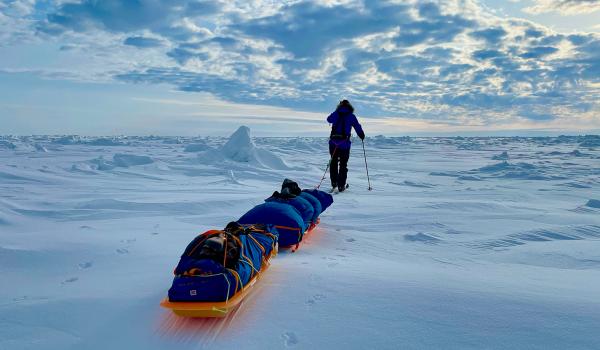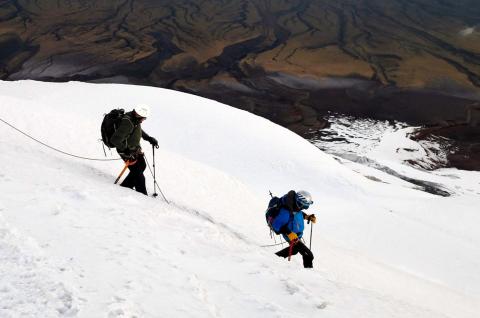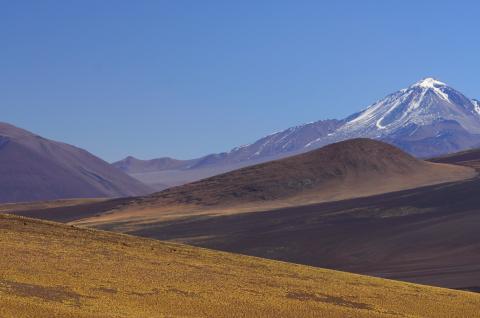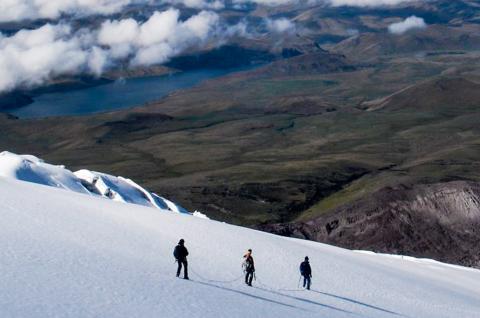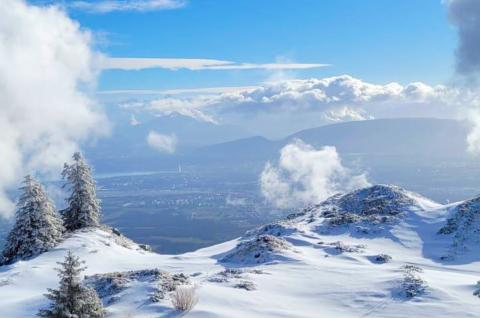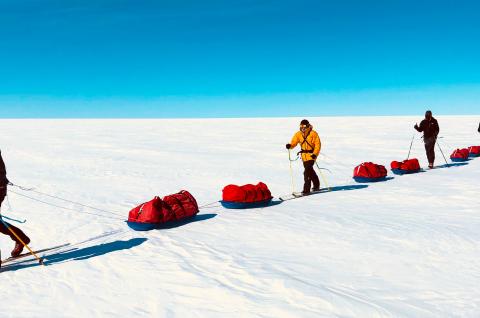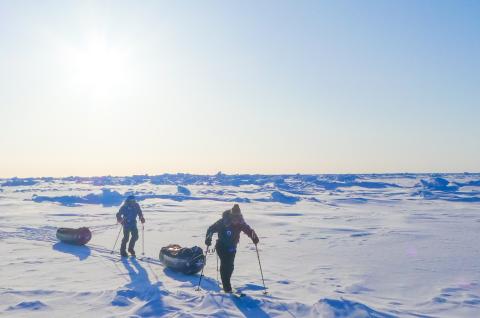A legendary polar crossing in the footsteps of the giant Roald Amundsen
Highlights
- Fully autonomous expedition
- Accompanied by an experienced Polar Experience guide
- Preparation for polar expeditions in the high Arctic, especially the North Pole
- Immersion in raw, untamed nature over varied terrain with rich wildlife
- H24 personalized weather forecast and polar doctor
- Small groups of 4 to 6 participants
With a maximum of six participants, we experience a rare polar adventure, on the mythical route of the Northwest Passage, 400 kilometers over pack ice from Cambridge Bay to Gjoa Haven in Canada's Far North. This maritime route linking the Atlantic and Pacific oceans takes us in the footsteps of explorer Roald Amundsen, who first opened this route in 1906. With its varied terrain and wildlife, the route takes us through polar bear territory. We are accompanied by an experienced polar guide on this human adventure, where commitment and team spirit are the order of the day. A rare French-speaking expedition, and excellent preparation for future polar expeditions to the high Arctic, especially the North Pole.
Overview
As soon as we land in Cambridge Bay (Ikaluktutiak in Inuktitut), Nunavut, we feel the special atmosphere of this historic expedition, following in the footsteps of explorer Roald Amundsen.
A century earlier (in 1906), Amundsen opened the sea route between the Pacific and Atlantic Oceans; we will be following in part of his footsteps, linking Cambridge Bay to Gjoa Haven (Uqsuqtuuq in Inuktitut) 400 kilometers further east.
We first need a few days off to get our routines properly in place and adapt the pace of progress within our team.
Our route will take us to Jenny Lind Island, but we soon find ourselves back on sea ice and confronted with the tricky passage of the pressure ridges. It is a physical challenge to find our way through these meanders of fast-moving ice, and to navigate our pulkas, which remind us that we are towing no less than 90 kilos each.
Twenty days of physical and mental challenge to reach Gjoa Haven, where team spirit will be the necessary constant for our success, in an environment of bitter cold and wind.
Although pulka skiing is not technically demanding, we have to be able to keep up the pace over the 400 kilometers of skiing and keep our GPS on course.
A grandiose spectacle, varied terrain, the possibility of spotting seals, musk oxen, ptarmigan... But let's not forget that the Canadian Arctic is home to the polar bear, and its presence has been confirmed. We need to be vigilant, and perhaps even bring a dog along for protection during this rare adventure.
Skiing is also about enjoying the enchantment and fascination of the immensity that surrounds us, taking pleasure and reflection in our own bubble, and realizing a rare expedition, developed by Expeditions Unlimited thanks to their long experience of committed polar expeditions.
Itinerary
Days 1 & 2: Arrival in Cambridge Bay
Day 1
We land at Cambridge Bay airport from Europe, then make our way to our hotel where the rest of the group is waiting for us.
Day 3: Preparation day
Day 3
After breakfast at the hotel, the day will be devoted to the final preparation of the expedition, with a review of the equipment, administrative formalities and final purchases before departure. Collective equipment is shared between us on an equitable basis. We check every piece of equipment, to avoid any unpleasant surprises once we are on the expedition. Together, we prepare the daily food rations, taking into account caloric requirements and allowing for a few safety days.
Day 4: Departure of the expedition to the Canadian Arctic
Day 4
After breakfast, we set off on our 400-kilometer, twenty-day expedition... As with any expedition, we adjust our pulka skiing pace at the start of this valley, accepting the omnipresence of the cold, and finding our feet so that we can build up our strength over the following days. Above all, we have to take our time and pace ourselves, not give in to the excitement of the start. We are still on dry land, but not for much longer.
As the day draws to a close, we set up the first camp, and are happy to be back in our comfortable sleeping bag after our first day on skis.
Days 5 to 23: Ski pulka itinerance on the Northwest Passage
Day 5
The following days take us in the historic footsteps of explorer Roald Amundsen, who opened the sea route linking the Atlantic and Pacific Oceans in 1906.
The first few days are spent on sea ice, then we have to weave between compression ridges and make our way through this immensity of ice, not forgetting that we are dragging a pulka loaded with nearly 90 kilos when we set off. Other passages are more slippery for skis and less technical, with a gentler relief, allowing us to increase our average daily mileage to around 20 kilometers a day.
Even if the effort required is considerable, we have to spare ourselves to set up our camp every day and satisfy the immutable ritual of melting snow with the help of the stove for our water and preparing our freeze-dried rations.
Every morning, the tents are dismantled, carefully folded and stowed away in our cleverly organized pulkas, without forgetting to erase all traces of our passage before each morning's departure.
Long days on skis, a chance to appreciate the immensity that surrounds us, to reflect and meditate in this silence, and perhaps the chance to catch a glimpse of certain animals: seals, ptarmigan and musk oxen. Although the tracks are sometimes visible and fresh, we must not forget that we are in polar bear territory; we must remain vigilant.
Our route takes us to Jenny Lind Island, before returning to sea ice for at least 3 or 4 difficult days amidst compression ridges. We have to take into account the vagaries of the weather, whose changing moods make our daily progress variable, making kilometers almost impossible. We may even have to spend a day in a tent to allow the storm or the piterack, Greenland's very strong katabatic wind, to pass.
Our guide's experience and the weather forecasts received by satellite from our private weather router based in Europe enable us to opt for the best solution. In any case, we have to try and keep up our pace to reach our goal and get to the village of Gjoa Haven on time.
The last part of the expedition is mostly on sea ice. Particular vigilance is required when skiing on a very thin layer of snow deposited on blue ice, a delicate progression, especially with pulkas that are still quite heavy. The same applies to thin ice, where our guide helps us to find the best trajectories.
Soon enough, we should be able to see a radar base antenna in our sights, and to use this landmark to “dock” on King William Island. After weaving our way between compression ridges, hummocks (mounds of ice blocks formed by the pressure of pack ice) and seal holes, we reach land once again, accompanied by the ballet of snow ptarmigans and watched by musk oxen, impressive for their build and thick fleece.
Even though we are dependent on our arctic polar environment, be it wind, whiteout (white day with very little visibility) or storms, we still have a hundred kilometers to go to reach our goal. The team's motivation and the excitement of reaching our final goal tend to accelerate our pace of progress, despite the fatigue. With Gjoa Haven soon in sight, we need to stay focused.
Day 24: Arrival in Gjoa Haven
Day 24
This last day is a special one, as it marks the success of our expedition, while at the same time saluting the team spirit everyone has nurtured, not forgetting that our physical and mental strength has been called upon daily during the almost three-week expedition from Cambridge Bay to Gjoa Haven.
But it also means that this great adventure is coming to an end, as we soon see the multicolored roofs of the houses and the antenna overlooking Gjoa Haven. Our pace has inevitably quickened, and we observe the first signs of human life and smells, giving us renewed energy for the last few kilometers. Our emotions are palpable as the tips of our skis enter the village, cutting off our virtual finishing line.
Together, we make our way back to the comfort of a real hotel room. There is no better feeling than warm water on the skin. A truly restorative dinner allows us to celebrate the end of this adventure, before falling asleep in a real cosy bed!
Day 25: End of expedition formalities
Day 25
After a comfortable night's sleep in a hotel and a hearty breakfast, the day is mainly devoted to packing up the equipment for transport back to Europe. A few administrative formalities to be settled on site.
It is also an opportunity to discover the village of Gjoa Haven and return to the comfort of dinner and another night at the hotel.
Days 26 & 27: Contingency day
Day 26
We save these 2 days in case the weather has prevented us from flying the day before, or if we have fallen behind schedule during the expedition due to bad weather conditions.
Days 28 & 29: Return to Europe
Day 28
After a final night in Gjoa Haven, we are transferred by cab to the airport to catch our first flight back to Europe.
Day 30: Landing in Europe
Day 30
END OF EXPEDITION
For reasons that cannot be foreseen at this stage, such as unpredictable weather, the physical fitness or lack of fitness of participants or other circumstancess (customs formalities, road conditions, traffic, landslides, force majeure, etc.), your expedition leader may have to adapt the program, if necessary, to ensure the smooth running of your trip. He remains the sole judge and the one who guarantees your safety. Activity times are given as an indication and may vary from one participant to another.
The itinerary for all our expedition programs, or the ascent program for our high-mountain expeditions, are given here as a guide only. They are flexible enough to adapt to weather conditions with a few contingency days. In any case, you should follow the recommendations of your guide, who may suggest that you cancel your expedition due to weather, safety or physical conditions.
It is important to remember that this is a truly unsupported expedition, and that anything can happen. Expeditions Unlimited, your expedition leader, your guide or our local teams can in no way be held responsible.
Any costs incurred as a result of a change in the expedition schedule (extra nights' accommodation, extra flights) will be borne by the participants and not by the organizers. "Contingency days" refer to the expedition in the strict sense of the term (base camp/base camp in the mountains, departure point/exit point on a traverse, etc.).
Any early return of the expedition or of certain members only (early success, abandonment, etc.), generating costs for accommodation, meals, changes to air tickets or other activities not provided for in this program, will be charged in full to the participants.
Trip notes
Guiding
Your expedition leader is an English and French-speaking polar guide from the Polar Experience team (see description above), highly experienced in polar environments and group management. His or her name will be announced less than six months before departure.
He/she represents Expeditions Unlimited in dealings with the group, our partners and local authorities. He/she takes the decisions necessary for the expedition to run smoothly. His authority is decisive and indisputable. You must respect his or her decisions, as well as those taken collectively.
If, for reasons beyond our control, our planned guide is unable to lead the group, he will be replaced by another experienced polar guide. The services would not be modified, the conditions of the trip would be identical and this change would not constitute a valid reason for cancellation.
And throughout the program, we will rely on other local skills as required. Finally, we will have access to highly experienced and personalized weather forecast services and an Ifremmont doctor, a specialist in cold and isolated environments, on the H24 hotline.
For unpredictable reasons at this stage, like adverse weather conditions, insufficient physical condition of participants, insufficient competencies of participants related to the intended activities, your guide may decide to adjust the intended program and/or activities. At all times, his decision will be final on all matters likely to affect the safety and well-being of the trip.
Difficulty level
Level rated: difficult
This program is aimed at participants in good physical shape, with a significant sport practice, endurance in particular, holding a strong mental to face difficulties that are unforeseen by nature.
The main difficulty of this expedition lies in its duration and the potentially extreme climatic conditions. Temperatures at this time of year can reach –40°C.
Participants carry the loads in their pulkas, which weigh around 90 kg at the start. Good physical and mental condition is therefore imperative. Each participant is responsible for the application of safety rules, equipment and maintenance, setting up camp and preparing meals. As always in this type of project, the key to success is teamwork and team spirit.
Meeting point
We meet at Cambridge Bay and take off again from Gjoa Haven.
Flights to and from Europe pass through Montreal, Toronto or Edmonton. Numerous airlines serve the main Canadian cities: Air France / KLM, Delta Airlines, Continental, Lufthansa, and others. The choice is determined by the level of baggage allowance and the cost of excess baggage, which is now prohibitive on some airlines.
From these capital cities, Canadian North serves the villages of Cambridge Bay and Gjoa Haven.
Given the diverse origins of the participants on this trip, international outward and return flights are not included in this package. In most cases, we book flights on your behalf to ensure that the whole group arrives at the destination at the same time. We do not charge any fees for these air bookings. Please do not hesitate to contact us. If you book your own tickets, we will advise you on the ideal flight schedule to enable all participants to arrive within a reduced time frame. At the very least, you need tickets that can be modified.
Accommodations
This package includes four nights' accommodation in a single room, two in Cambridge Bay and two in Gjoa Haven.
During the expedition, nights are spent in two-person tents.
Meals
Meals are provided in hotels or restaurants, both on departure from Cambridge Bay and on arrival at Gjoa Haven, for a maximum of 4 days.
During the expedition, meals are prepared in advance in the form of rations containing soups and freeze-dried meals for breakfast and dinner. Snacks (energy bars, dried meat, dried fruit, chocolate, etc.) are provided during the progression. They give us all the calories we need for the expedition, with the emphasis on balance, weight and ease of preparation.
Transfers / Transport
All transfers between the airport and our accommodation are done by cab and taken care of by your guide.
Group size
The group is composed of 4 to 6 participants maximum. The number of participants is deliberately limited to allow for greater immersion, to avoid embarrassing our hosts, and to develop freedom and flexibility. However, the maximum number may be exceeded if the last person to register wishes to travel with one or more other people. The services will not be modified, and the conditions of the trip will remain the same.
Equipment
Personal equipment is not provided. However, a complete list is provided to allow you to check that you are taking what is necessary.
All logistical equipment is provided, including tents and pulkas, as well as collective equipment such as stoves, gasoline, etc.
Your guide is equipped with a satellite phone, other telecommunications and emergency equipment, and a geolocation beacon.
Personal equipment is not provided. A complete list is given below, which you will review with your expedition leader. A more detailed list will be provided once you have registered.
We offer cold-weather equipment for hire (down sleeping bag, down jacket, etc.), as well as Nordic backcountry touring skis, skins, poles and boots adapted to this environment, which you should try out thoroughly before setting off.
Our commitments to sustainable development
Our commitment to a better planet has been a reality since the beginning of our story but we always need to do more and better. Please find out more about our charter and our commitments in terms of sustainable development. We have drafted our charter and take action through six themes on which we act as concretely as possible, most often with you: social equity and cultural respect, preservation of water, waste management in expedition, protection of biodiversity, raise public awareness on these subjects and finally, the optimization and recovery of CO2 emissions.
Regarding carbon emissions, most of which are due to air travel, we calculated and communicated in 2018 on the carbon footprint of each of our programs, expressed in tonnes of CO2.
These calculations made us aware of the importance of the total carbon emissions generated by our activity. Also, we have committed in 2022 to a carbon reduction that we believe is unprecedented in the tourism industry, aiming to reduce the total emissions of our activity by 5% per year, taking 2019 as the reference year (3,430 tonnes of CO2). This commitment is in line with the trajectory of the Paris climate agreements of 2015, the current benchmark. Thus, in 2030, we commit ourselves not to exceed 2,160 tonnes of C02. Thus, our maximum “carbon” budget for 2024 is 2,950 tonnes and for 2025, this budget will be reduced to 2,800 tonnes. And so on until 2030. To find out more about all of our calculations and our commitments in terms of reducing our carbon emissions.
In addition, since 2019, we have been encouraging you when you book for your journey to contribute with a donation to an independent NGO, among the two we have selected that share the commitments made in our charter. We matched the amount of this donation to this program's carbon footprint. Thus, the journey you are considering generates 2,08 tons of CO2, which corresponds to a 100% donation of €62 for an estimated value today of €30 per tonne of CO2. This donation remains of course optional and you can decide to give between nothing and 100% of this amount. Since 2019, including covid years of 2020 and 2021, we have been able to collect thanks to you nearly €7,000 for these associations.
Please do not hesitate to come back to us with any questions you might have regarding this carbon footprint mechanism, our other sustainable développement commitments or even to share with us your experience through a chat or a mail at contact@secret-planet.com.
Polar Experience guiding
This program is guided by a Polar Experience guide, accredited by the IPGA (International Polar Guides Association) with a solid experience in the polar regions and who adhere to a specific working method to help participants achieve their goals on an individual basis. They frequently lead participants in Svalbard, Iceland, Greenland, towards the North Pole, the South Pole and elsewhere in Antarctica like in Queen-Maud Land. Not only are they some of the best polar guides in the world, but they also have first-rate teaching and interpersonal skills, making the experience you are about to have, with and thanks to them, even rarer.
These guides were all trained by our late Dixie Dansercoer, who tragically passed away in June 2021 in Greenland. With many years of polar experience, he had developed a high-level team with a specific approach which can be summarized as follows:
- Respect for the environment: going places and leaving no traces, this is what we implement the best way we can during all our Polar Experience guided trips and expeditions. As expeditions are inherently based on a minimalist’s attitude, we stick to the basics and avoid excesses. Respect for local cultures.
- Safety: our knowledge and know-how has been developed with a major focus on maximum experience and minimal risk for our participants. Preparation and high-quality equipment are obviously two major issues with no compromise. We have as well weather, medical and rescue partners on stand-by 24/7. Your guide has a satellite telephone, an Iridium Go! VHF radio, mountaineering safety equipment, a location beacon, GPS and other equipment necessary for a journey in the best safety conditions.
- Preparation & training: full immersion in physical and mental training, equipment knowledge, First Aid basics, logistical challenges and crisis management. Understanding the environmental, cultural and geographical characteristics of polar environment, learning from pioneering and contemporary expeditions. Preparation calls and expeditions training (theory, practice) over a weekend.
- High quality equipment: constant improvements and customized adjustments for maximum efficiency and performance. Screening of personal clothing and advice on purchase of special polar clothing at partner stores with special discounts.
Julie Brown, Dixie's partner of many years, now leads this dynamic little team.
Each participant receives the useful book, Polar Exploration: A practical handbook for North and South Pole expeditions, hard cover or electronic version, written by Dixie Dansercoer, which is the reference handbook that explains all aspects of polar journeys and expeditions: polar environment, safety, preparation, training and equipment.
Departures and pricing
Please find below all dates and prices for this expedition. Prices are quoted "from" and may be adjusted notably according to the number of participants (see trip notes for details). Please note that dates and prices for years beyond 2024, when given, are for guidance only and are subject to change and readjustment to take account of current economic realities.
No date works for me!
I initiate a new datePrice includes
- Accommodation in hotels and guesthouses in Cambridge Bay and Gjoa Haven for up to 4 nights
- Meals in Cambridge Bay and Gjoa Haven for up to 4 days
- Airport/hotel transfers in Cambridge Bay and Gjoa Haven
- Experienced French-speaking polar guide
- Meals in the form of freeze-dried rations during the expedition, plus snacks
- Tents for two people, stoves and fuel
- Pulka and harness per participant, collective progression and safety equipment
- Safety satellite phone ( only for the guide)
- Canadian taxes and permits
- Experienced and personalized weather forecast services during expedition
- Medical follow-up by Ifremmont during the expedition (see above)
- Face-to-face and/or remote preparation meetings
- Live coverage of the expedition for your community (supply of InReach beacon, IridiumGo and subscriptions, LivExplorer service configuration)
Price does not include
- Any customs taxes upon arrival in Canada
- Possible import taxes for satellite phones, professional communications equipment and commercial filming
- Expenses related to shifts in the expedition schedule (additional nights' accommodation beyond 4 nights in Canada, meals beyond 4 full-board days, air supplements, etc.)
- Expenses related to the early return of the expedition or of certain members only (abandonment, etc.), generating costs for transfers (snowmobile, vehicle, plane, etc.), accommodation, meals, plane ticket changes or other activities not included in this program
- Tips for the guide, to be shared with other participants to your satisfaction
- Any personal communications by satellite telephone (to be paid locally)
- Hotel nights, full board and other personal expenses during face-to-face preparatory meetings
- Personal equipment (see list below)
- Drinks and any personal expenses (personal visits, cabs, souvenirs, dry-cleaning, etc.)
- Travel and expedition insurance (assistance, evacuation and repatriation)
Your custom expedition
We put our expertise, our knowledge of the terrain, our creativity, our experience, the quality of our guides and the reliability of our partners at your service to build your custom expedition. We can also personalize an expedition to your wishes as soon as you form a "closed" group, whatever the number of participants.
This means that, unless you authorize us to do otherwise, no outside participants join you, and we can personalize your expedition by adapting it to your own pace, with the program extensions you desire, a higher level of comfort, certain activities, other encounters, etc.
Every expedition of this type is subject to a specific quotation. To get in touch with us now, please fill in the short questionnaire below. One of our experts will get back to you to refine your request and make you a proposal.
